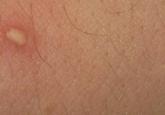Case Letter

Identification of Cutaneous Warts: Cryotherapy-Induced Acetowhitelike Epithelium
Cutaneous warts are benign proliferations of the epidermis that occur secondary to human papillomavirus infection. The diagnosis of cutaneous...
Ted Rosen, MD; Anita Nelson, MD; Kevin Ault, MD
Dr. Rosen is from the Department of Dermatology, Baylor College of Medicine, Houston, Texas. Dr. Nelson is from the Department of Obstetrics and Gynecology, Harbor-UCLA Medical Center, Torrance, California. Dr. Ault is from the Department of Gynecology and Obstetrics, Emory University School of Medicine, Atlanta, Georgia.
The clinical studies reported in this article were sponsored and funded by Valeant Pharmaceuticals International, Inc. Dr. Rosen has served on the advisory board for and has received honoraria from Valeant Pharmaceuticals North America, LLC. Drs. Nelson and Ault have been advisors for Valeant Pharmaceuticals North America, LLC. Dr. Nelson also has received honoraria and is a consultant and speaker for Actavis and Bayer Health Care Pharmaceuticals; has received research grants from Agile Therapeutics and Bayer Health Care Pharmaceuticals; and is a consultant for Agile Therapeutics, ContraMed LLC, Merck & Co, Microchips Biotech, PharmaNest, and Teva Pharmaceutical Industries Ltd. She also is a speaker for Merck & Co; Pfizer, Inc; and Teva Pharmaceutical Industries Ltd.
Correspondence: Ted Rosen, MD, Department of Dermatology, Baylor College of Medicine, 1977 Butler Blvd, Houston, TX 77030 (vampireted@aol.com).

We assess the safety and efficacy of imiquimod cream 3.75% and 2.5% in men with external genital warts (EGWs). Two multicenter, randomized, double-blind, placebo-controlled studies were conducted in a total of 447 (225 from study 1 and 222 from study 2) male patients (aged ≥12 years) with 2 to 30 EGWs and a total wart area of 150 mm2 or greater. Participants were randomized (2:2:1) to imiquimod cream 3.75% or 2.5% or placebo applied once daily until complete clearance or a maximum of 8 weeks (end of treatment [EOT]). There was an 8-week follow-up period (end of study [EOS]) for participants who did not achieve complete clearance by EOT. Participants who achieved complete clearance were observed for an additional 12 weeks. The primary efficacy end point was complete clearance rate. Safety assessments included visual assessment of local skin reactions, number and duration of required rest periods, adverse events (AEs), and clinical laboratory tests. Study results indicated that new imiquimod formulations are beneficial in treating EGWs in men.
Practice Points
External genital warts (EGWs), which are caused by infection with select types of human papillomavirus (HPV), are one of the most prevalent and fastest growing sexually transmitted infections.1 External genital warts affect approximately 1% of sexually active adults in the United States and Europe, with another 15% having subclinical infections; more than 1 million new cases of EGWs are diagnosed annually.2-4 Although the condition is not life threatening, lesions can cause symptoms, such as burning, itching, bleeding, pain and dyspareunia, and potential urethral or rectal obstruction. External genital warts also have been associated with adverse psychological effects.5-8
The time between exposure to HPV and development of EGWs can vary from a few weeks to several months or years (median, 2.9 months).9 Many HPV infections are mild and transient, resolving spontaneously.10 As many as 30% of EGWs will regress over 4 months and approximately 90% clear within 2 years.11,12 However, even with treatment, the median time to resolution is 5.9 months.9
Imiquimod cream 5%, which has been successfully used to treat EGWs since it was approved by the US Food and Drug Administration in 1997, is applied to lesions 3 times weekly at bedtime until clearance is achieved or for a maximum of 16 weeks.13 In clinical studies, complete clearance has been reported in 35% to 75% of participants.14-21 However, it is important to note that not all anogenital regions with warts were required to be treated in these studies,14-21 and newly arising warts were not included in the analysis.17 Reported clearance rates were higher and median clearance time was shorter in women.17 Relatively low recurrence rates (6%–26%) have been reported after successful clearance of EGWs.16,17,20,21
Long treatment durations are always a concern for patient adherence. Although increasing the dosing frequency with imiquimod cream 5% might be considered an attractive option to reduce the length of the treatment course, it has resulted in greater incidence and severity of local adverse events (AEs) in some studies without improved efficacy.18,22,23 Thus lower concentrations of imiquimod (ie, 2.5% and 3.75% formulations) were developed to potentially decrease treatment duration and provide a daily dosing regimen.
We report the results of 2 identical, placebo-controlled, phase 3 studies evaluating the safety and efficacy of imiquimod cream 2.5% and 3.75% in treating EGWs in men. Pooled results from a female subgroup previously have been reported.24 Although the percentage of women who reported ever being diagnosed with EGWs was higher than in men (7.2% vs 4%) in one survey,25 other assessments have found a similar prevalence of EGWs among both genders.26-28 We provide important insights herein by reporting efficacy and tolerability data for imiquimod cream 2.5% and 3.75% in the treatment of EGWs in males.
Methods
Study Design
Male patients aged 12 years and older with 2 to 30 EGWs in the inguinal, perineal, and/or perianal areas as well as on the glans penis, penile shaft, scrotum, and/or foreskin were enrolled in 2 identical, multicenter, randomized, parallel-group, double-blind, placebo-controlled studies. Participants were randomized (2:2:1) to self-treatment with imiquimod cream 3.75% or 2.5% or placebo once daily until complete clearance was achieved or for a maximum of 8 weeks (end of treatment [EOT]). There was a follow-up period of up to 8 weeks (end of study [EOS]) in participants who did not achieve complete clearance by EOT. All participants who achieved complete clearance by EOS entered a 12-week observational follow-up period to assess recurrence.
Primary and Secondary Efficacy Criteria
The primary efficacy end point was complete clearance rate, which was defined as the proportion of participants by the EOS visit with zero EGWs (that either existed at baseline and any warts developing during the study) in all anogenital anatomic areas. It is important to note that this primary efficacy end point was very conservative in that it included any new warts occurring during the study that may not have received a full treatment course. Lesions were counted in all assessed anatomic areas without distinction between those that were identified at baseline or those that were newly identified during the study period. If new EGWs appeared during the study in new anatomic areas, such lesions were treated with the study medication as they appeared. Therefore, any newly arising EGWs received less than the full course of treatment, as therapy was not extended beyond the 8-week study period. Participants were evaluated for the presence of any EGWs in all anatomic areas without distinction between lesions that were present at baseline and newly arising EGWs. Therefore, development of new EGWs during the study period could potentially lower clearance rates.

Cutaneous warts are benign proliferations of the epidermis that occur secondary to human papillomavirus infection. The diagnosis of cutaneous...

Lasers have become an important part of the dermatologist’s arsenal for the treatment of skin diseases. As such, familiarity with the usage and...
Vestibular papillomatosis (VP) is a benign condition of the female genitalia that may be mistaken for condyloma acuminatum (genital warts).
